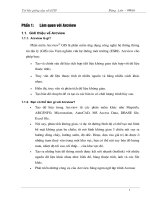Tài liệu giảng dạy CCNA - module 06 chapter 20-Point-to-Point Leased Line Implementation
Bạn đang xem bản rút gọn của tài liệu. Xem và tải ngay bản đầy đủ của tài liệu tại đây (340.36 KB, 20 trang )
1
Module 06 WAN
Technology
Chapter 20
Point-to-Point Leased Line Implementation
2
Table of Content
1
Review of WAN Basics
2
Data-Link Protocols for Point-to-Point Leased Lines
3
Authentication Over WAN Links
3
1. Review of WAN Basics
4
Overview of WAN
The three main categories of WAN options:
Leased point-to-point lines
Dial lines (also called circuit-switched lines)
Packet-switched networks
5
Physical Components of Point-to-Point
Leased Lines
WAN switch WAN switch
CSU
CSU
CO CO
TELCO
CPE
CPE
Demarc
Demarc
6
2. Data-Link Protocols for Point-to-
Point Leased Lines
7
The important comparison points between
HDLC and PPP.
Protocol Error Correction Architecte Type Field Other Attributes
HDLC No No HDLC serves as Cisco’s
default on
serial links. Cisco uses a
Proprietary
Type field to support
multiprotocol
traffic. Supports
synchronous links
only.
PPP Support but not
enabled by
default
Yes PPP was meant for
multiprotocol
interoperability from its
inception,
unlike HDLC. PPP also
supports
asynchronous
communication.
8
Configuring HDLC/PPP Encapsulation
Enter the interface configuration mode of the serial
interface.
Then enter the encapsulation hdlc command to specify
the encapsulation protocol on the interface.
When communicating with a non-Cisco device, synchronous
PPP is a more viable option.
9
PPP-Specific Features
Error detection.
Looped link detection.
Multilink support.
Authentication.
1
0
Looped Link Detection
LCP notices looped links quickly using a feature called
magic numbers. When using PPP, the router sends PPP LCP
messages instead of Cisco-proprietary keepalives across
the link; these messages include a magic number, which is
different on each router. If a line is looped, the router
receives an LCP message with its own magic number
instead of getting a message with the other router’s magic
number.
1
1
Enhanced Error Detection
PPP LCP analyzes the error rates on a link using a PPP
feature called Link Quality Monitoring (LQM). LCP at each
end of the link sends messages describing the number of
correctly received packets and bytes. The router that sent
the packets compares this number to the number of
packets and bytes it sent, and it calculates percentage loss.
The router can be configured to take down the link after a
configured error rate has been exceeded.
The only time this feature helps is when you have
redundant routes in the network. By taking down a link that
has many errors, you can cause packets to use an
alternative path that might not have as many errors.
1
2
3. Authentication Over WAN Links
1
3
PPP Authentication Protocols:PAP
1
4
PPP Authentication Protocols:CHAP
CHAP is used at the startup of a link and periodically
verifies the identity of the remote node using a
three-way handshake.
1
5
PPP Authentication Protocols:CHAP
Operation
Sydney Hongkong
Challenge
01IDRandomSydney
Username Password
Sysney cisco
Melbourne sanhinoon
MD5
Hash #
Response
02IDHash#Hongkong
Username Password
Hongkong cisco
Melbourne sanhinoon
MD5
Hash #
Is Equal?
03IDAck/NackSydney
1
6
PPP Encapsulation And
Authentication Process
1
7
Configuring PPP authentication
Step 1: Define username and password to expect from
remote router
Router(config)#username remote password secret
Secret must be the same at both ends
Step 2: Enable PPP
Router(config-if) encapsulation ppp
Step 3: Configure authentication
Router(config-if) Ppp authentication { pap|chap|pap-
chap|chap-pap}
Step 4: if IOS 11.1 or later, PAP must be enable on
interface
Router(config-if)ppp pap sent-username user
password pass
1
8
Configuring PPP authentication: PAP
1
9
Configure PPP authentication: CHAP
2
0
Summary
HDLC & PPP
PAP & CHAP









